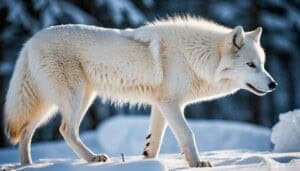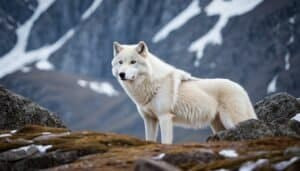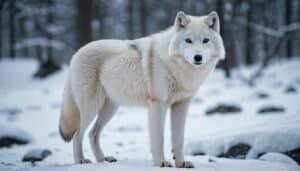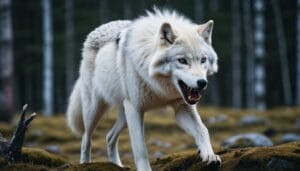Introduction
Arctic wolves are fascinating predators whose diet reflects the harsh and variable conditions of their environment
This article explores the primary components of an Arctic wolf’s diet, including their hunting techniques, seasonal variations, and the influence of prey availability. By understanding these elements, we gain insight into how these resilient animals survive and thrive in one of the world’s most extreme habitats
Primary Components of an Arctic Wolf’s Diet
Arctic wolves primarily subsist on a diet composed of various animals found within their tundra habitat. Understanding the key elements of their diet helps us appreciate their adaptability and predatory skills
Arctic Hares
Arctic hares are a significant part of the Arctic wolf’s diet. These hares are abundant in the tundra and provide a reliable food source. Arctic wolves hunt hares by using their keen sense of smell and exceptional speed
Hares are typically caught during solo hunts, as they are small and fast, making them ideal prey for individual wolves
Lemmings
Lemmings are another staple in the Arctic wolf’s diet. These small rodents are plentiful and easy to catch, especially during their population peaks. Arctic wolves often dig through snow and vegetation to uncover lemmings’ burrows
While lemmings are a primary food source, their population can fluctuate dramatically, leading wolves to adapt their diet accordingly
Caribou
Caribou are the largest prey animals that Arctic wolves hunt. Hunting caribou requires cooperation and strategic planning, usually involving the entire wolf pack
Wolves work together to isolate weak or young caribou from the herd, making it easier to take down these large animals. Caribou provide a substantial amount of meat, which can sustain the pack for an extended period, especially during harsh winters
Birds
Birds and their eggs also contribute to the Arctic wolf’s diet. During the nesting season, wolves often raid bird nests for eggs, which are rich in nutrients
Ground-nesting birds are particularly vulnerable to wolf predation. Birds are an important food source, especially when other prey is scarce
Smaller Mammals
In addition to hares and lemmings, Arctic wolves hunt other small mammals, such as arctic ground squirrels and voles. These animals are less consistent in the diet but still play a crucial role, particularly when larger prey is not available
The wolves’ ability to hunt a wide range of small mammals showcases their adaptability
The diverse diet of the Arctic wolf highlights its adaptability and survival skills in the harsh Arctic environment. By preying on a variety of animals, from small rodents to large caribou, Arctic wolves ensure their sustenance year-round
Hunting Techniques of Arctic Wolves
Arctic wolves employ a variety of hunting techniques that allow them to capture prey efficiently in their challenging environment. These techniques range from pack hunting strategies to solitary hunting methods, and they adapt based on the season and availability of prey
Pack Hunting Strategies
Arctic wolves are highly social animals that often hunt in packs. This cooperative hunting strategy is essential for taking down larger prey, such as caribou. Pack hunting involves a high level of coordination and communication among wolves
They work together to isolate a target, using their collective strength to overpower it. Wolves may chase caribou for long distances, taking turns to maintain their stamina and eventually exhaust the prey
Pack hunting is not only effective for capturing large animals but also helps to ensure that all members of the pack get fed. This communal effort strengthens the social bonds within the pack and increases the survival rate of each member
Solitary Hunting Methods
In addition to pack hunting, Arctic wolves also hunt alone, especially when targeting smaller prey like Arctic hares and lemmings. Solitary hunting requires stealth, patience, and speed
Wolves rely on their keen senses of smell and hearing to locate prey. Once they detect a target, they approach quietly and pounce quickly to capture it
Solitary hunting is more common in seasons when small prey is abundant or when a wolf is temporarily separated from its pack. This method allows wolves to be flexible and opportunistic, making the most of the available food resources
Seasonal Hunting Variations
The hunting techniques of Arctic wolves vary with the seasons. During the summer, when prey is more plentiful, wolves may focus on hunting smaller animals that are easier to catch. The abundance of birds, eggs, and small mammals provides a diverse diet. Wolves also take advantage of the long daylight hours to hunt more frequently
In the winter, when the tundra is covered in snow and prey is scarcer, Arctic wolves rely more on their pack hunting skills to take down larger animals like caribou. The harsh conditions require them to be more strategic and cooperative
Wolves often travel long distances to find food, using their keen sense of smell to track down prey hidden beneath the snow
The adaptability of Arctic wolves in their hunting techniques is crucial for their survival in the extreme Arctic environment. Whether hunting alone or in a pack, they demonstrate remarkable skills and cooperation to secure their food
Seasonal Variations in the Diet
The diet of Arctic wolves changes with the seasons, reflecting the availability of different prey types and the harsh conditions of their environment. Understanding these seasonal variations provides insight into how Arctic wolves adapt to survive throughout the year
Summer Diet Changes
During the summer months, the Arctic tundra becomes more hospitable, and a wider variety of prey is available. The abundance of small mammals, birds, and their eggs provides Arctic wolves with diverse food sources. In this season, Arctic wolves often hunt Arctic hares, lemmings, and ground-nesting birds
The increased daylight hours of summer allow wolves to hunt more frequently and take advantage of the plentiful prey. Wolves may also hunt young caribou, which are more vulnerable during this time
The variety and abundance of prey during summer help the wolves build up their strength and store energy for the harsher winter months
Winter Diet Adjustments
Winter in the Arctic is characterized by extreme cold, limited daylight, and deep snow, making hunting more challenging for Arctic wolves. During this season, the availability of small prey like hares and lemmings decreases, and wolves rely more heavily on larger prey, such as caribou and muskoxen
Pack hunting becomes essential in winter, as it allows wolves to take down large animals that can provide substantial amounts of meat to sustain the pack. Wolves may travel great distances in search of prey, using their acute sense of smell to detect animals hidden beneath the snow
The harsh conditions also force wolves to be more strategic and cooperative in their hunting efforts
Adaptation to Scarce Prey
In times when prey is particularly scarce, Arctic wolves exhibit remarkable adaptability. They may scavenge on carrion, including leftover kills from other predators or animals that have died due to the harsh conditions. This scavenging behavior ensures that the wolves can find food even when hunting opportunities are limited
Arctic wolves are also known to eat smaller mammals and even fish when other prey is not available. This dietary flexibility is crucial for their survival in the unpredictable Arctic environment. By adjusting their diet according to the season and availability of prey, Arctic wolves demonstrate their resilience and adaptability
The seasonal variations in the diet of Arctic wolves highlight their ability to adapt to the extreme conditions of their habitat. Whether hunting small mammals in the summer or large prey in the winter, these wolves showcase their remarkable survival skills
Influence of Prey Availability on Diet
The availability of prey significantly influences the diet and survival strategies of Arctic wolves. Understanding this relationship helps to reveal how these predators adapt to fluctuating prey populations and the challenges posed by their environment
Impact of Prey Population Fluctuations
Prey populations in the Arctic can vary dramatically from year to year, impacting the diet of Arctic wolves. For instance, lemming populations undergo cyclical booms and busts, which directly affect the wolves’ food sources
During lemming population peaks, Arctic wolves can rely heavily on these rodents, which are abundant and easy to catch
Conversely, when lemming numbers decline, wolves must adapt by shifting their focus to other prey, such as Arctic hares, birds, and larger mammals like caribou. This ability to switch between prey types is vital for the wolves’ survival, ensuring that they can find food even during periods of scarcity
Adaptation to Scarce Prey
When prey becomes scarce, Arctic wolves exhibit a range of adaptive behaviors. One key adaptation is their ability to travel long distances to find food. Wolves can cover extensive territories, sometimes roaming over hundreds of miles, to locate sufficient prey
During times of prey scarcity, wolves may also increase their reliance on scavenging. They consume carrion, including remains left by other predators and animals that have died from natural causes. This opportunistic feeding strategy helps to sustain the wolves when hunting is less successful
Moreover, Arctic wolves demonstrate social flexibility, sometimes forming larger packs to increase hunting efficiency and improve their chances of capturing larger prey. Conversely, they may also disperse into smaller groups or hunt alone to reduce competition for limited food resources
Importance of Prey Diversity
The diverse diet of Arctic wolves, which includes a variety of small mammals, birds, and larger ungulates, plays a crucial role in their survival. By not relying on a single prey species, wolves can better withstand fluctuations in prey populations
This dietary diversity ensures that they can find alternative food sources when their preferred prey is unavailable
The influence of prey availability on the diet of Arctic wolves underscores their adaptability and resilience. By responding to changes in prey populations and utilizing a range of feeding strategies, Arctic wolves manage to thrive in one of the most challenging environments on Earth
Other Animals in the Arctic Wolf’s Diet
Beyond their primary prey, Arctic wolves have been observed consuming a variety of other animals. This dietary flexibility is essential for their survival in an environment where food availability can be highly unpredictable
Smaller Mammals
In addition to Arctic hares and lemmings, Arctic wolves also hunt other small mammals such as arctic ground squirrels and voles. These animals are less consistently part of the diet but become important when primary prey species are scarce
Small mammals are often caught using similar techniques as those used for hares and lemmings, relying on the wolves’ keen sense of smell and hearing to locate and capture them
The presence of these smaller mammals in the Arctic wolf’s diet highlights their opportunistic feeding behavior. By taking advantage of whatever prey is available, wolves ensure they can sustain themselves even when preferred food sources are not abundant
Occasional Scavenging
Scavenging is another critical aspect of the Arctic wolf’s feeding strategy. In the harsh Arctic environment, food can be scarce, and wolves must take advantage of every opportunity to eat. They are known to scavenge on the carcasses of animals that have died from natural causes, environmental conditions, or other predators
Scavenging provides a vital food source, especially during the winter months when hunting is more challenging. Arctic wolves may consume remains of caribou, muskoxen, and other large mammals
This behavior not only helps wolves survive during lean times but also plays an essential role in the ecosystem by cleaning up carrion that could otherwise spread disease
Birds and Their Eggs
Birds and their eggs are particularly important during the spring and summer when many bird species migrate to the Arctic to breed. Ground-nesting birds, such as ducks and geese, provide both adult birds and eggs as food sources. The high nutritional value of eggs makes them a prized part of the diet during the nesting season
Arctic wolves often raid nests to consume eggs, and they may also catch fledglings that are not yet capable of strong flight. This opportunistic hunting helps supplement their diet during times when other prey might be less available
The inclusion of these various animals in the Arctic wolf’s diet demonstrates their adaptability and resourcefulness. By diversifying their food sources, Arctic wolves are better equipped to handle the fluctuations in prey availability that characterize their extreme habitat
Conclusion
The diet of Arctic wolves is a testament to their adaptability and resilience in the harsh Arctic environment. They rely on a variety of prey, ranging from small mammals like Arctic hares and lemmings to larger animals such as caribou
Their hunting techniques, whether solitary or pack-based, demonstrate a high level of cooperation and strategy, essential for capturing different types of prey
Seasonal variations significantly influence their diet, with wolves adjusting their feeding habits based on the availability of prey. In the summer, they benefit from an abundance of small mammals and birds, while in the winter, they rely more on larger prey and scavenging to survive
The fluctuations in prey populations further highlight the wolves’ ability to adapt, utilizing diverse food sources to ensure their sustenance year-round
By exploring the primary components of their diet, hunting techniques, and the impact of prey availability, we gain a comprehensive understanding of how Arctic wolves thrive in one of the world’s most extreme habitats
Their dietary flexibility and resourcefulness are key factors that enable them to maintain their population despite the challenging conditions of the Arctic tundra










